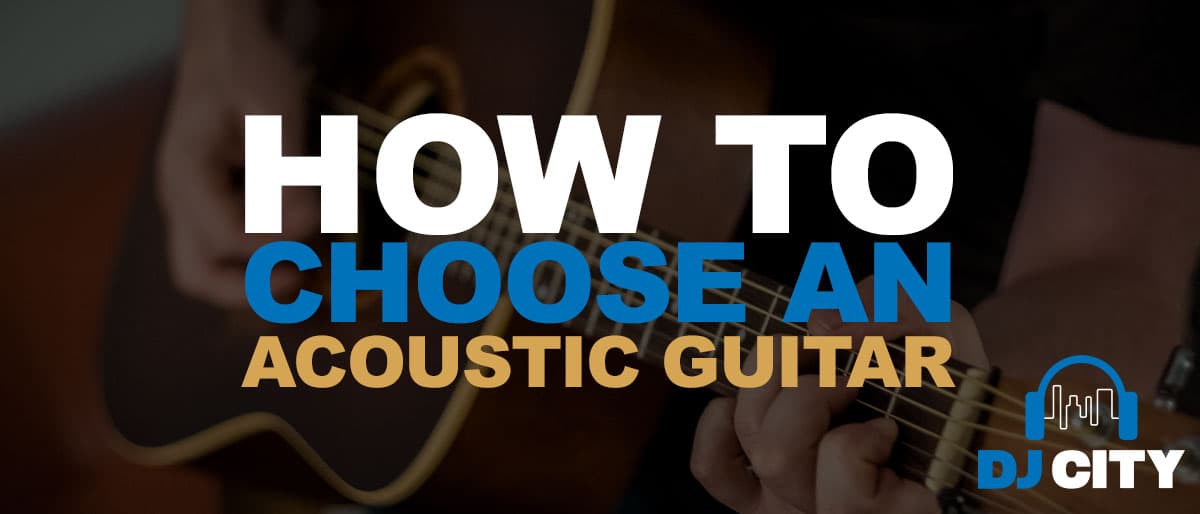
How to Choose an Acoustic Guitar – The Complete Guide
Looking to buy your first acoustic guitar? Aerosmith guitarist, Joe Perry, says his first guitar was awful. “There were two strings missing, and the other ones were half an inch off the neck. If there was ever a guitar designed to turn you off playing, it was that one. It hurt so much to play, to have to press down those heavy strings.”
Perry overcame the bad start and went on to be a rock star. But for many budding guitarists, a bad guitar might put them off for life. They’ll think they can’t play, or guitar is ‘too hard.’ That’s why choosing a first guitar is important. First impressions last.
So, what should you look for when choosing to buy an acoustic guitar? Here’s a look at the key factors, mainly for beginners, but with a few words for experienced players too.
- Why you should buy an Acoustic Guitar first
- How much should you pay for your first guitar?
- Types of Acoustic Guitars
- Acoustic Guitar Sizes
- What if You Can’t Decide What Guitar to Buy?
- What if Your Child is Left-Handed?
- Extras and Packages
- For the experienced player
Why you should buy an Acoustic Guitar first
As a guitar teacher, I’ve taught lots of beginners. While most come to class with an acoustic guitar, a few have gone straight for an electric. This always feels premature. But is there any actual reason you should start with an acoustic?
Yes, there is. To play an acoustic guitar is to know the instrument in its purest form. There are no tricks coming from an amplifier, no effects to make you sound artificially better. You have to learn to make sound by the simple actions of hands upon strings. Once that is understood, you’re better placed to go to an electric guitar if you want to.
It’s also easier to go from acoustic to electric than the other way around.
How Much Should You Pay for Your First Guitar?
I’ll never forget the 19 year old beginner who came to his first lesson with a $3000 Gibson Les Paul, just like his favourite guitarist, Slash from Guns and Roses. Indeed the student’s guitar was better than mine! It was a bit weird, like seeing a P-plater driving a Ferrari. Still, you have to admire the kid’s ambition.
Beginners don’t need a guitar that good. Indeed, the problem with starting at the top is the only way you can go is down. It’s best to start with a basic or mid-range guitar that reflects your ability level, then buy a better one when you improve and show some commitment to practicing.
In the past, cheap guitars were a bit rough, but these days the quality is good even on budget models. In fact, guitar is one of the most affordable musical instruments around. You can buy a decent acoustic guitar for beginners for around $100, or into the $200-300 range for slightly better quality. Really, that is all you need to start you on a lifelong path to playing guitar.
Then again, if budget is no issue, what the hell, buy a $3000 Gibson Les Paul!
Types of Acoustic Guitars
The main choice to make is between a steel string or a nylon string guitar. They sound and feel different. Steel string guitars have a brighter, slightly louder sound, which many find appealing. They’re more often used in popular songs. Here’s an example of a steel string acoustic, played by Paul Davids https://youtu.be/T-U3c1nU3eM although it’s worth remembering these songs could also be played on a nylon-string instrument.
Nylon string guitars are a little softer, with a rounded, mellow tone. Also known as a Spanish guitar, the classical repertoire is played on these, as shown in this piece by Ana Vidovic.
They can also be used in pop music. Sting plays one on the song ‘Fragile,’ although he is using a different model
A more practical concern is how the nylon and steel strings feel to play. Some of the most unplayable beginner acoustic guitars I’ve seen have had steel strings, although to be fair, there are plenty of good ones these days. As a rule, though, nylon string guitars are softer and easier on tender beginner fingers.
It takes a while for the fingers to develop ‘calluses’ – which are areas of toughened skin that help you press down the strings. In normal language, the word callous means ‘unfeeling,’ and while that’s a bad way to be emotionally, it’s actually good for your fingers to be unfeeling! The calluses means you can press down guitar strings for hours without your fingers getting sore.
The nylon string guitar also has a wider neck. This means the strings are slightly further apart. Some adults with thick fingers find it hard to fit their fingers on the thinner necked steel string or electric guitars, and the wider neck on the Spanish helps with this.
On the other hand, a wider neck can make some chords harder to play – like bar chords. There’s always a trade-off.
Acoustic Guitar Sizes
Most guitars are full size, but they also come in half or three quarter size. A simple rule to follow is a half size person needs a half size guitar. So, young children between the age of about five to ten should use a half size guitar. Kids eleven to fifteen may like a three-quarter, but adults should use normal size. Adult beginners with small hands might like to try a three quarter.
What if You Can’t Decide What Guitar to Buy?
A rookie guitarist can feel overwhelmed by choice. But really, you don’t need too much information about types of wood, guitar parts, and other technical details. After all, when you bought your first computer, you didn’t need to know everything about RAM, bytes, and browsers.
Your first guitar is not your guitar for life, it’s just something to start on. Ideally, you should get experience playing different types of guitars. A good path would be to play a nylon string in your first year, a steel-string in your second, and an electric in your third. If you’re still playing after three years, you’ll know which guitar is for you. More likely, if you’re serious, you’ll have one of each. After all, how many guitars do Keith Richards or Brian May own? Dozens!
There may, of course, be a storage issue. Perhaps you don’t have space in your house to keep all those guitars. Don’t worry, there’s a simple solution. Just move to a bigger house.
What if Your Child is Left Handed?
One veteran guitarist tells the story of walking into a music shop as a young man in the 1980s, and asking to buy a left-handed guitar. The shop owner replied ‘Get out of here, loser, and come back when you can play right-handed.’
Of course, music shop owners are much more polite these days, especially the friendly staff at DJ City! But what was behind such a response? The fact is 90% of guitars are set up to be played right-handed. That means the left-handed player will have a pretty limited choice in any given music shop. He or she also won’t be able to pick up a spare guitar at a party and jam. That’s why the shop owner kindly ‘advised’ our friend to learn right handed.
So, should the lefty learn to play right-handed? This is one of the more controversial questions. Unlike on the piano or saxophone, the left and right hands perform different roles on the guitar. The weaker hand pushes the strings down to the fret board, the stronger one picks or strums them. Because these are quite different actions, I’m inclined to think a left-hander should play left-handed, with the dominant arm doing the picking or strumming. And after all, just think of the musical greats who were left-handed – like Jimi Hendrix, Paul McCartney, Tony Iommi, and Kurt Cobain.
On the other hand, navigating the guitar world is easier if you’re right-handed, and some natural lefties have indeed learned to play that way. So, what to do if your child is a lefty? The best option is to buy a nylon string acoustic. As their shape is pretty much symmetrical, you can try learning right-handed, but if it doesn’t feel right, it’s easy to swap the strings around so they’re set up for left-handed. That doesn’t work on other types of guitars.
Extras and Packages
Apart from the instrument itself, you’ll need a few extras – a guitar case, picks, and perhaps a tuner. Once again, there are choices. A hard case protects the guitar if it’s dropped, but they’re heavier to carry and more expensive. A soft case also protects the guitar from jolts and will keep the rain off, and they’re lighter to carry. A soft case is usually enough to start with.
You can generally get a package deal where these extras are included with the guitar. In fact, it’s never been easier and more affordable to get started in music.
For the Experienced Player
If you’ve been playing a while, you should have a fair idea what to look for in a guitar, but there are far more choices to make in terms of brands and prices. If you’re looking to buy a new acoustic, once again you can choose between a nylon or steel string model. This usually comes down to genre. If you’re playing classical, or other music with a lot of finger picking, a Spanish classical guitar is for you. These guitars also suit Latin styles like bossa nova. If you want to play gypsy jazz, country, or pop, you’ll probably go for a steel string.
As for brands, look at what the pros use. After all, they can play anything. It’s fair to assume they know what to look for in a guitar, and have made an informed choice. On the other hand, sometimes a lesser known brand can be just as good, but it’s cheaper simply because it is less well known. This is a factor if you’re working to a set budget.
If you plan on performing or busking, you’d be wise to look for an acoustic guitar with a built in pickup so you can amplify the sound. Otherwise, you simply won’t be loud enough. It is possible, however, to add a pickup to your acoustic guitar, so it need not come pre-installed.
That ends this brief introduction on how to buy an acoustic guitar. If this is your first guitar, there’s no need to stress. It’s your first, not your last – and if you fall in love with the guitar, it will be the first of many.













